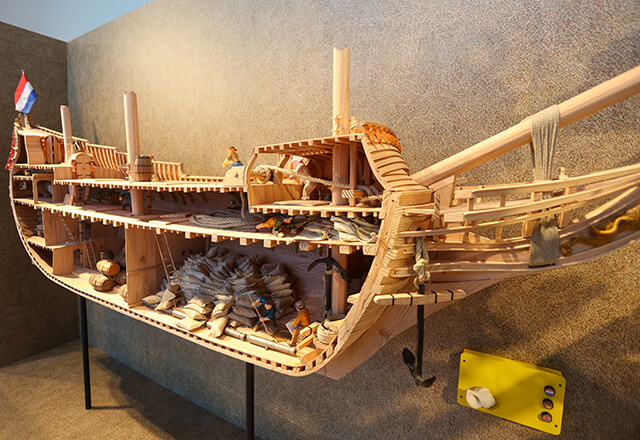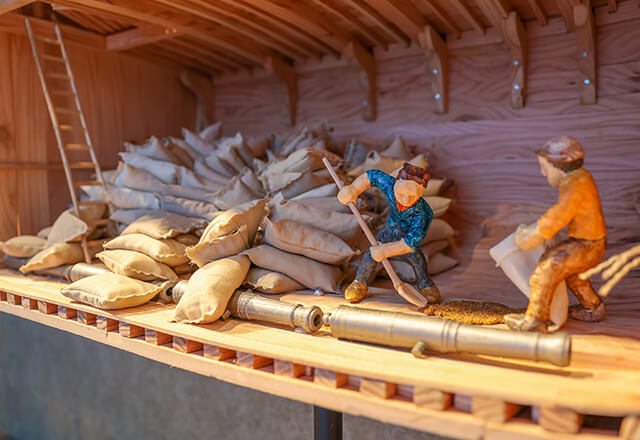 Take a look aboard a fluyt! You can discover this model ship in the exhibition World Voyage, in the North point of the compass. Here you can clearly see how the roles were divided on such a seventeenth century ship: the sailors are working hard whilst the captain is celebrating a good business deal with a merchant in his cabin, enjoying wine and delicious spices. Intricate scenes make it a pleasure to study the whole of the model ship, also for children. You can see the cook furiously chasing a sailor who has stolen something. The orlop deck is so low that the crew had to crawl through it. Grain was shovelled and carried around, but there are also a couple of sailors resting in a hammock. The ship is full of sacks of grain, so it wasn’t strange that mice also travelled along on board. A challenge for children is to find all of the mice.
Take a look aboard a fluyt! You can discover this model ship in the exhibition World Voyage, in the North point of the compass. Here you can clearly see how the roles were divided on such a seventeenth century ship: the sailors are working hard whilst the captain is celebrating a good business deal with a merchant in his cabin, enjoying wine and delicious spices. Intricate scenes make it a pleasure to study the whole of the model ship, also for children. You can see the cook furiously chasing a sailor who has stolen something. The orlop deck is so low that the crew had to crawl through it. Grain was shovelled and carried around, but there are also a couple of sailors resting in a hammock. The ship is full of sacks of grain, so it wasn’t strange that mice also travelled along on board. A challenge for children is to find all of the mice.
Efficient
 You won’t see many people in the model. This is historically correct: a fluyt ship could function with a relatively small crew. The ship could be manned with twelve men. Fluyts were extremely suitable for transporting large quantities of bulk goods, such as grain or wood. They weren’t fast but they were efficient. These characteristics made them one of the secrets of Dutch maritime success. About 500 fluyts departed from Texel for the Baltic Sea every year.
You won’t see many people in the model. This is historically correct: a fluyt ship could function with a relatively small crew. The ship could be manned with twelve men. Fluyts were extremely suitable for transporting large quantities of bulk goods, such as grain or wood. They weren’t fast but they were efficient. These characteristics made them one of the secrets of Dutch maritime success. About 500 fluyts departed from Texel for the Baltic Sea every year.
Large cargo ships
Fluyts were long, large three-masted ships with a pear-shaped stern. They were built in various sizes, with the longest being about 37 metres long. They could transport up to 350 tonnes of goods. Most fluyts were either unarmed or minimally armed, as they were not warships.
This model of half a ship has been specially designed for the exhibition by model builder Marc Visser.

